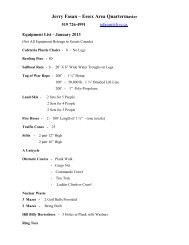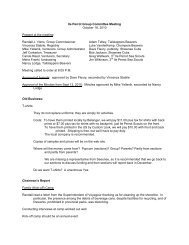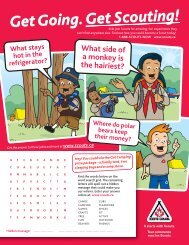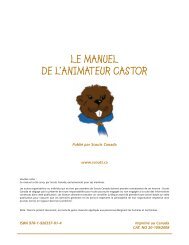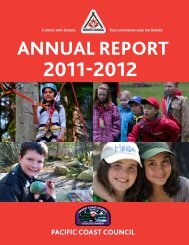Beaver Leader's Handbook - Scouts Canada
Beaver Leader's Handbook - Scouts Canada
Beaver Leader's Handbook - Scouts Canada
Create successful ePaper yourself
Turn your PDF publications into a flip-book with our unique Google optimized e-Paper software.
Keep the characters hidden until they take their place on the board so your audience doesn’t<br />
know what’s coming next. And remember to face the <strong>Beaver</strong>s, not the board!<br />
When the story is over, ask your <strong>Beaver</strong>s to help you take the characters off the board. They’ll<br />
remember the story as they do the job, and probably will start telling it to each other.<br />
Finger Plays<br />
Before telling a story to the <strong>Beaver</strong>s, think of hand movements you might incorporate. <strong>Beaver</strong>s<br />
enjoy finger plays like these.<br />
The <strong>Beaver</strong>s<br />
Five little <strong>Beaver</strong>s sitting on a well (Cup hands)<br />
One peeped in and down he fell (Raise one finger)<br />
<strong>Beaver</strong>s jumped high (Raise hands and wave above head)<br />
<strong>Beaver</strong>s jumped low (Lower hands to floor)<br />
<strong>Beaver</strong>s jumped everywhere, to and fro.<br />
Four little <strong>Beaver</strong>s... etc.<br />
Ten Galloping Horses<br />
Ten galloping horses came through the town (Wiggle 10 fingers)<br />
Five were white (Hold up left hand)<br />
Five were brown (Hold up right hand)<br />
They galloped up and galloped down (Wiggle 10 fingers)<br />
Then galloped away, out of town! (Hide hands behind back)<br />
Mood Stimulators<br />
Drama workshops often encourage leaders to make use of exercises which help youngsters<br />
develop their dramatic potential. You can use any of the following examples very effectively for<br />
this purpose.<br />
Warm-ups<br />
4 Shaking and stretching<br />
4 Frozen tag, poison tag<br />
4 Different styles of movement (e.g. slow motion, fast motion, in mud, sand, water, etc.)<br />
Statues<br />
Start in pairs where each <strong>Beaver</strong> takes a turn being the sculptor who makes his or her partner<br />
into a statue. First let them choose whatever theme they like and later narrow it down to a particular<br />
area like sports, occupations, etc.<br />
Gradually increase the size of the groups. Let them become statues illustrating what happy,<br />
excited, watching, listening and smelling look like. Combine the emotions with earlier themes<br />
(e.g. an excited hockey player; a bored bus driver).<br />
Try sequential statues. Think of the baseball player up to bat, for example. What is the batter’s<br />
first position, next position, and next?<br />
Characters<br />
Let <strong>Beaver</strong>s imagine certain situations, and build characters from them (e.g. a group of people<br />
in an elevator, waiting for a bus, at a party).<br />
Try role playing. Assign <strong>Beaver</strong>s characters, situations, and a problem to resolve.<br />
14-15



